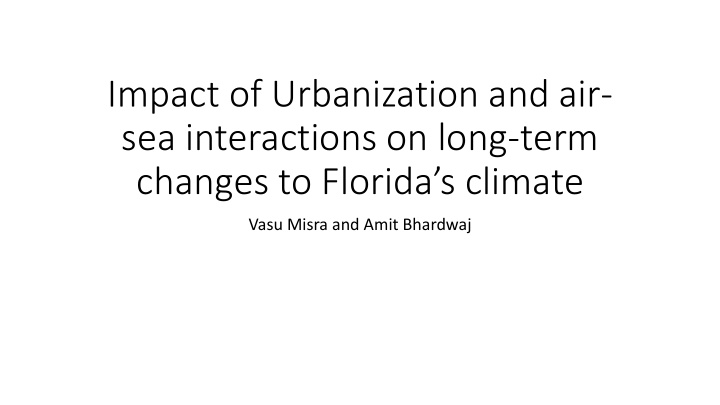



Impact of Urbanization and air- sea interactions on long-term changes to Florida’s climate Vasu Misra and Amit Bhardwaj
Impact of urbanization • Urban areas throughout Florida Peninsula are experiencing shorter, increasingly intense wet seasons relative to rural areas • We find that wet season length has decreased by about three and half hours per year in Florida’s most urban areas compared to its most rural areas in the last 40-60 years. • The linear trends of T min in urban areas of the SE united States approximately 7 ∘ F/century compared to 5.5 ∘ F/century in rural areas (Earlier work)
The distribution of the land cover (PIZA index, ERS 2005) spanning over three decades a) 1980, b) 1990, and c) 2000 .
The time series of the climatological daily rainfall (red) and the corresponding accumulated daily rainfall anomaly (blue) with onset (OD) and demise (DD) date indicated (in Julian day) for a) Miami, b) Daytona Beach, c) Jacksonville, d) Tampa, e) Orlando, and f) Fort Myers.
Decomposition of the time series of onset dates for Jacksonville
An overlay of the slope of the observed linear trends (shaded) in a) onset (days/year), b) demise (days/year) dates and c) seasonal length (days/year) and d) accumulated rainfall (mm/year) of the wet season on the PIZA index for the year 2000. The PIZA index of 1, 2, 3, and 4 correspond to dots, slanted lines, horizontal lines and diamond shape in the background.
The observed linear trends (shaded) in a) onset (days/year), b) demise (days/year) dates and c) seasonal length (days/year) and d) accumulated rainfall (mm/year) of the wet season. The hatched regions indicate passing the Mann-Kendall test for significance (p≤ 0.05).
The scatter of the linear trend of a) onset date, b) demise date c) length, and d) seasonal accumulation of wet season rainfall over peninsular Florida with PIZA index is plotted. The units of the slope of the linear fit to the scatter (blue line with median slope) in the 3 panels (a, b, and c) is days/year/PIZAindex and for seasonal rainfall accumulation (bottom left) is mm/season/year/PIZAindex. The gray shaded lines represent the 95% confidence interval of the linear fit.
Impact of air-sea coupling • Future climate change projections (2041-2060) indicate significant drying (up to 2-3 mm/day less than current climate) uniformly across Peninsular Florida in all 4 seasons of the year in presence of air-sea coupling • In absence of air-sea coupling the projected change in precipitation is moderate to insignificant (~±0.5mm/day w.r.t. current climate) with non-uniform patterns of change across Peninsular Florida and across seasons • These differences between the two types of model set ups arise because of significant changes in oceanic evaporation and moisture flux convergence owing to changes in SST projections
Grid spacing: 139km x 100km for land Grid spacing: 10km x 10km 123km x 45km for ocean
OBSERVATIONS RSM-ROMS CCSM4 The annual mean surface eddy kinetic energy plotted on a log scale with base 10 (cm 2 s -2 ) from a) observations (Obs), b) RCM, and c) CCSM4 20 th century simulation. d) The monthly mean volume flux (Sv=10 6 m 3 s -1 ) through the d) Yucatan Channel and e) Florida Strait (computed between Florida and Cuba at 80.031°W) from SODA reanalysis (black), RCM (blue), and CCSM4 (red) 20 th century simulations
SE CCSM4 Observations RSM-ROMS CCSM4 SE RSM-ROMS SST Depth of 26C isotherm Depth of 20C isotherm
20 th century (1986-2005) verification of precipitation simulation RSM-ROMS Observations CCSM4 RSM SE CCSM4 SE RSM-ROMS SE RSM Uniformly rains less in southern and central FL DJF and rains more in northern FL in all models CCSM4 rains less while MAM RSM rains more in spring in all models Uniformly rain less in JJA summer in all models Uniformly rain more in SON fall in all models
21 st century change (2041-2060 ) of precipitation with respect to 20 th century (1986-2005) simulation DJF MAM JJA SON Insignificant to CCSM4 moderate increase in rainfall Much drier climate RSM-ROMS throughout the year in a future climate Insignificant to moderate decrease in RSM rainfall
21 st century change (2041-2060 ) of SST with respect to 20 th century (1986- 2005) simulation SST Depth of 26C Depth of 20C RSM-ROMS CCSM4
Heat Flux through Yucatan Channel HF YC CONVERGENCE = HF YC -HF FS Heat Flux through Florida Strait (HF FS )
Conclusions • Urbanization affects both rainfall and temperature: reduces the length of the wet season, increases the intensity of the rain, and warms the temperature • Air-sea coupling at high spatial resolutions suggest a dire future climate for RCP8.5 emission scenario over Florida with significant drying across peninsular Florida. This is characterized by significant reduction in terrestrial evaporation, and moisture flux divergence, and a slowing down of the Loop Current circulation in the Gulf of Mexico. • Global models are unreliable to produce the changes over the oceans surrounding Florida and therefore their projected change over terrestrial Florida is also highly uncertain
Recommend
More recommend